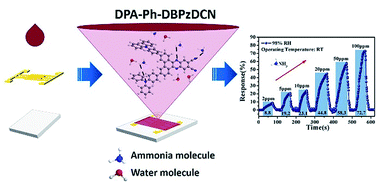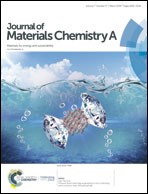A rapid-response room-temperature planar type gas sensor based on DPA-Ph-DBPzDCN for the sensitive detection of NH3†
Abstract
The development of rapid-response gas sensors for the detection of NH3 gas at room temperature still remains a huge challenge and is limited by the poor room-temperature sensing materials and their unsatisfactory sensing characteristics. Herein, an organic semiconductor, 3,6-bis(4-(diphenylamino)phenyl)dibenzo[a,c]pyrazine-11,12-dinitrile (DPA-Ph-DBPzDCN),-based planar type sensor was successfully developed for the detection of NH3 at room temperature. Moreover, the DPA-Ph-DBPzDCN NH3 sensor displayed satisfactory properties including significant response/recovery characteristic, selectivity and stability under the effect of relative humidity. Especially, at 98% RH, it had the highest response value of 72.73% to 100 ppm NH3, and the detection limit could be as low as 2 ppm. Furthermore, the sensor showed the rapid response and recovery times of 48 s and 15 s to 20 ppm NH3, respectively, good repeatability and stability. In addition, the excellent gas-sensing property of DPA-Ph-DBPzDCN was explained and attributed to the interaction between NH3 and the N-group of DPA-Ph-DBPzDCN. These results obtained from a series of studies provide a new strategy and methodology for the development of room-temperature ammonia gas sensors.



 Please wait while we load your content...
Please wait while we load your content...